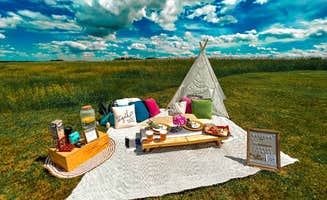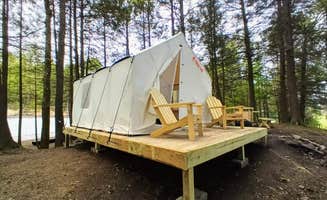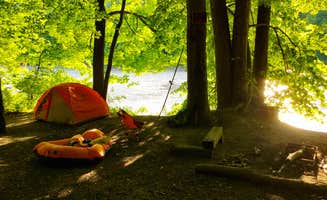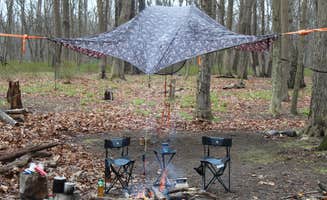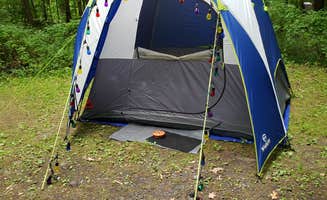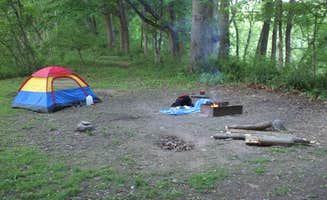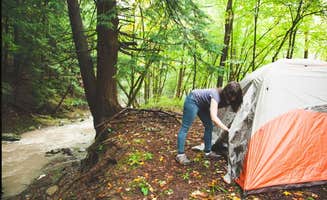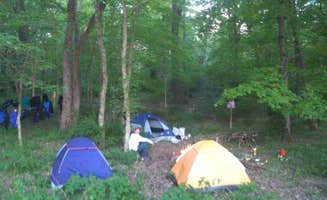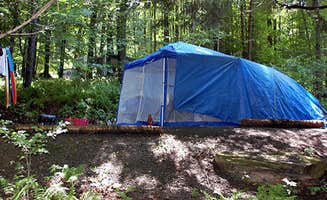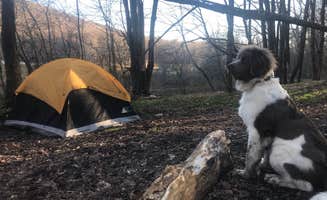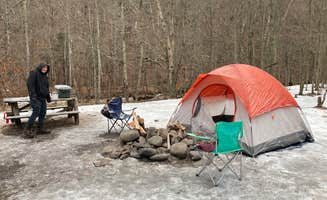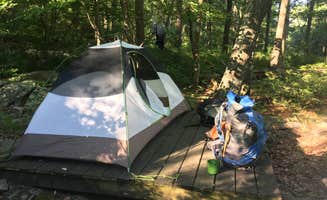Tent camping around Narrowsburg, New York centers on the Upper Delaware River, which forms part of the border between New York and Pennsylvania at elevations ranging from 600-900 feet. The region experiences four distinct seasons with summer temperatures averaging 70-85°F during peak camping months (June-August), while spring and fall bring cooler temperatures that many campers prefer for hiking and exploration. Primitive camping options in this area typically require advance planning for water needs, especially at river sites where treatment is necessary.
What to do
Waterfall exploration: Within a short distance of river campsites, several accessible waterfalls provide day trip opportunities. From Namanock Island, "If you paddle across the river from the site, it is only a 10-15 minute hike along the road on the Pennsylvania side of the river to reach Raymondskill Falls. A 'must-see' if your stopping here," notes camper John B. Multiple waterfalls can be found within hiking distance of river camping areas.
Fossil and artifact hunting: The Delaware River area contains rich historical sites dating back centuries. A camper at Sandyston Boat In Campsites mentions you can "search for abandoned/forgotten homes and mills, some of which date back to the 1700's, or try your luck at fossil and artifact hunting" on the Pennsylvania side of the river.
Night sky observation: The remote nature of island camping provides exceptional stargazing opportunities. "The island is situated in a way that once darkness falls there are no lights to be seen in either direction, up or down river," reports a Namanock Island camper, creating "an incredible view of the night sky" without light pollution interference.
What campers like
Island camping privacy: The isolation of camping on river islands creates a unique sense of solitude. A camper at Namanock Island shared, "You totally feel that your party is alone out on the river, the entire world is yours and yours alone. There are no public interactions beyond the neighboring sites on the river for miles." This seclusion is particularly valued by solo and small group campers.
Natural soundscapes: The ambient sounds of the river enhance the camping experience at water-adjacent sites. As one visitor to Hankins noted, it's "A very suitable place to camp and entertain with everyone." The constant river sounds mask other noises and contribute to the peaceful atmosphere.
Wildlife observation: The riverside location provides opportunities to view diverse wildlife. A camper at Namanock Island reported, "Saw tons of bald eagles flying near the site and while paddles birds playing and baby geese with their mommas!" Eagles, deer, and various bird species are commonly spotted throughout the camping season.
What you should know
River access challenges: Reaching water-accessible campsites requires careful planning. "Due to fluctuating water levels all of the islands that are used for camping have a cut wall cliff style approach, but these sites have a very steep and above average height to the shoreline making unloading both more tiring and more of a hazard than I prefer," notes a camper at Sandyston Boat In Campsites.
Limited stays enforced: National Park Service regulations strictly limit camping duration at river sites. A reviewer at Second District Brew Farm emphasizes that "People found camping at this site that are not on a river trip or that are camped at the site for longer than one day can expect to receive hefty fines from the NPS." Rangers regularly patrol the river to enforce these rules.
Seasonal site changes: The National Park Service occasionally modifies available camping locations. A camper noted that "The 2021 season has brought a few minor, but very important changes to the island. There are now only 3 approved sites on the entire island, eliminating 3 or 4 smaller sites that are regularly used by the public." Check current site availability before planning your trip.
Tips for camping with families
Spacious sites selection: Some riverside locations offer abundant space for family groups. At Sandyston Boat In Campsites, a reviewer noted sites were "very large and while covered by 40+ ft trees were open enough to make you wish you brought more gear and people just because it would fit." Sites 1 and 4 at Namanock Island are particularly recommended for families.
Wildlife education opportunities: The river environment provides natural learning experiences for children. "This area is rich in history, folklore, legends and locations that anyone camping here would truly enjoy knowing/seeing," mentions a camper at Minisink Campground, making it ideal for educational family camping.
Bathroom considerations: Most primitive sites lack formal facilities, challenging for families with young children. One parent noted about Sandyston campsites: "My daughter was happy to have a chance to have walls for privacy for a change. However, you are in a secluded area, next to a river... after examination she decided another night of primitive camping sans walls was ok with her." Bring portable solutions for family comfort.
Tips from RVers
Alternative camping options: While most river sites accommodate tents only, nearby locations offer more amenities. Quilted Woods provides a middle ground with cabin options while maintaining a natural setting, featuring firewood availability and toilet facilities while preserving the rustic camping experience just a short drive from Narrowsburg tent camping areas.
Parking considerations: For paddlers accessing river sites, secure parking is essential. A camper at Namanock Island advised: "There is a ten dollar fee per day to park your car so bring cash as the parking area is not always manned and you'll have to leave the fee in an envelope that is available just past the entrance." Plan for these additional costs when budgeting your trip.


